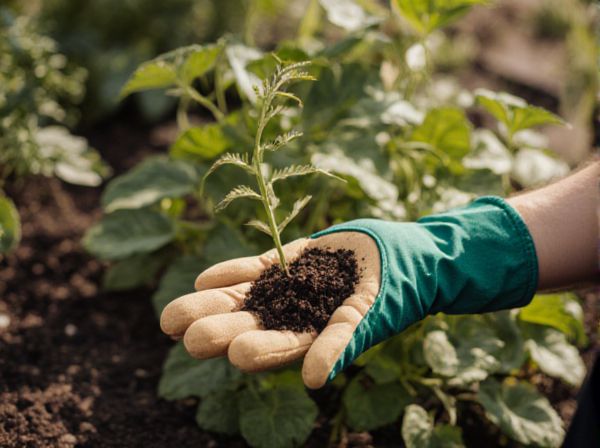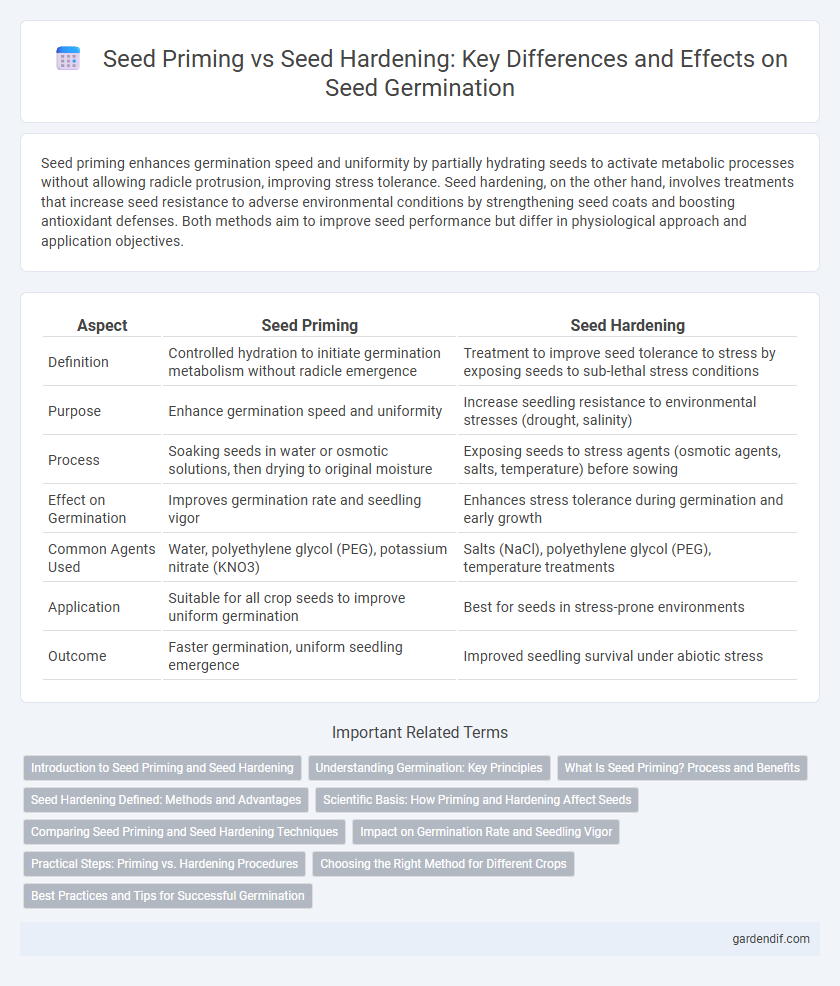
Seed priming vs Seed hardening Illustration
Seed priming enhances germination speed and uniformity by partially hydrating seeds to activate metabolic processes without allowing radicle protrusion, improving stress tolerance. Seed hardening, on the other hand, involves treatments that increase seed resistance to adverse environmental conditions by strengthening seed coats and boosting antioxidant defenses. Both methods aim to improve seed performance but differ in physiological approach and application objectives.
Table of Comparison
| Aspect | Seed Priming | Seed Hardening |
|---|---|---|
| Definition | Controlled hydration to initiate germination metabolism without radicle emergence | Treatment to improve seed tolerance to stress by exposing seeds to sub-lethal stress conditions |
| Purpose | Enhance germination speed and uniformity | Increase seedling resistance to environmental stresses (drought, salinity) |
| Process | Soaking seeds in water or osmotic solutions, then drying to original moisture | Exposing seeds to stress agents (osmotic agents, salts, temperature) before sowing |
| Effect on Germination | Improves germination rate and seedling vigor | Enhances stress tolerance during germination and early growth |
| Common Agents Used | Water, polyethylene glycol (PEG), potassium nitrate (KNO3) | Salts (NaCl), polyethylene glycol (PEG), temperature treatments |
| Application | Suitable for all crop seeds to improve uniform germination | Best for seeds in stress-prone environments |
| Outcome | Faster germination, uniform seedling emergence | Improved seedling survival under abiotic stress |
Introduction to Seed Priming and Seed Hardening
Seed priming involves controlled hydration of seeds to initiate metabolic processes without radicle emergence, enhancing germination speed and uniformity. Seed hardening exposes seeds to sub-lethal stress conditions, such as drought or salinity, to improve stress tolerance and seedling vigor. Both techniques optimize seed performance by modulating physiological and biochemical pathways during early germination stages.
Understanding Germination: Key Principles
Seed priming enhances germination by initiating metabolic processes before sowing, improving seed vigor and uniformity, while seed hardening focuses on increasing seed tolerance to environmental stresses by exposing seeds to controlled stress conditions. Both techniques manipulate physiological states to optimize germination speed and success under variable field conditions. Understanding these principles involves recognizing the balance between metabolic activation and stress adaptation to maximize seed performance.
What Is Seed Priming? Process and Benefits
Seed priming is a controlled hydration technique that initiates the early stages of germination without allowing radicle emergence. The process involves soaking seeds in water or osmotic solutions for a specific time, then drying them back to original moisture content to enhance enzymatic activities and metabolic processes. This method improves seed vigor, uniformity, and speed of germination, leading to better crop establishment and yield.
Seed Hardening Defined: Methods and Advantages
Seed hardening is a pre-sowing treatment that enhances seed tolerance to environmental stresses by gradually exposing seeds to osmotic agents or controlled moisture conditions, improving their germination performance under adverse conditions. Common methods include osmotic hardening using polyethylene glycol (PEG), hydropriming with water, and chemical hardening with salts or growth regulators to strengthen seedling vigor and stress resistance. The advantages of seed hardening encompass increased seedling establishment, improved drought and salinity tolerance, and uniform germination, contributing to higher crop yields.
Scientific Basis: How Priming and Hardening Affect Seeds
Seed priming enhances germination by initiating metabolic processes such as enzyme activation and DNA repair without radicle emergence, improving seed vigor and uniformity. Seed hardening induces stress tolerance through controlled exposure to sublethal stressors, activating antioxidant defenses and osmolyte accumulation that bolster resilience against adverse environmental conditions. Both techniques modulate physiological and biochemical pathways, optimizing seed performance and germination success under diverse conditions.
Comparing Seed Priming and Seed Hardening Techniques
Seed priming enhances germination by pre-soaking seeds in water or osmotic solutions to activate metabolic processes without radicle emergence, resulting in faster and more uniform seedling growth. Seed hardening involves soaking seeds in solutions containing growth regulators or beneficial substances like potassium nitrate, followed by drying, improving stress tolerance and seedling vigor under adverse conditions. While priming primarily accelerates germination speed, hardening focuses on enhancing seed resilience against environmental stressors such as salinity or drought.
Impact on Germination Rate and Seedling Vigor
Seed priming enhances the germination rate by initiating metabolic processes before sowing, resulting in faster and more uniform seedling emergence. Seed hardening improves seedling vigor by exposing seeds to mild stress, increasing their tolerance to adverse environmental conditions during early growth. Both techniques positively influence seed performance but target different physiological aspects critical for successful germination and seedling development.
Practical Steps: Priming vs. Hardening Procedures
Seed priming involves soaking seeds in water or a specific solution for a controlled period, followed by drying them back to their original moisture content to initiate metabolic processes without radicle emergence. Seed hardening entails subjecting seeds to mild stress conditions such as osmotic solutions, salt, or temperature treatments to enhance stress tolerance before planting. Both procedures require precise control of soaking duration, solution concentration, and drying methods to optimize germination rates and seedling vigor under varying environmental conditions.
Choosing the Right Method for Different Crops
Seed priming enhances germination speed and uniformity by partially hydrating seeds before sowing, making it ideal for crops like wheat and maize that benefit from rapid and synchronized emergence. Seed hardening involves treatments that strengthen seed resilience to stress, suitable for crops such as legumes and vegetables grown in challenging environments prone to drought or salinity. Selecting the appropriate method depends on crop species, environmental conditions, and specific stress factors to optimize germination success and seedling vigor.
Best Practices and Tips for Successful Germination
Seed priming enhances germination by pre-soaking seeds in controlled moisture to initiate metabolic processes without radicle emergence, resulting in faster and more uniform sprouting. Seed hardening involves treating seeds with salt or growth regulators to improve stress tolerance but may slow initial germination rates. For best results, optimize hydration levels according to species-specific requirements and ensure thorough drying post-treatment to maintain seed viability and maximize germination success.
Seed priming vs Seed hardening Infographic

 gardendif.com
gardendif.com